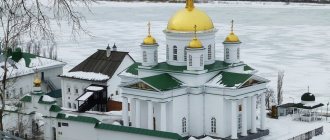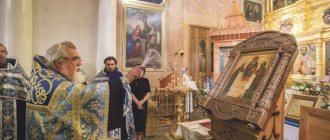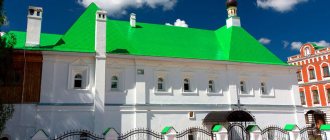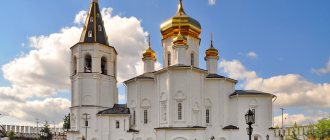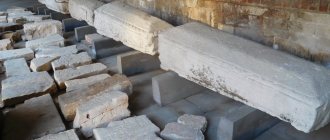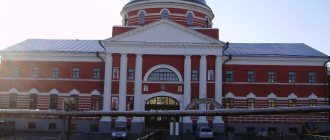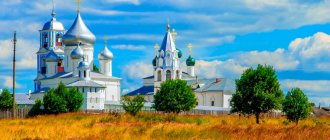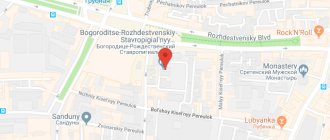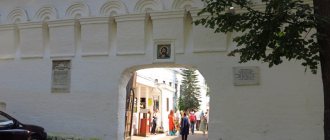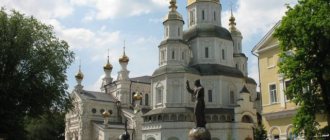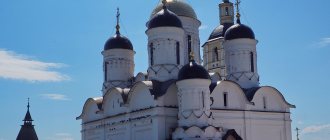Mir
Russia Vladimir Region Vladimir Nativity of the Mother of God Monastery (Vladimir) Map is loading…
{"format":"leaflet","minzoom":false,"maxzoom":false,"limit":50,"offset":0,"link":"all","sort":[""], "order":[],"headers":"show","mainlabel":"","intro":"","outro":"","searchlabel":"\u2026 \u0441\u043b\u0435\ u0434\u0443\u044e\u0449\u0438\u0435 \u0440\u0435\u0437\u0443\u043b\u044c\u0442\u0430\u0442\u044b","default":"","import-annotation":false,"width ":"auto","height":"350px","centre":{"text":"","title":"""link":"""lat":56.1311749999999989313437254168093204498291015625,"lon": 40.41307599999999666806616005487740039825439453125,"icon":""},"title":"","label":"","icon":"","lines":[],"polygons":[],"circles":[ ],"rectangles":[],"copycoords":false,"static":false,"zoom":8,"defzoom":14,"layers":["OpenStreetMap"],"image layers":[] ,"overlays":[],"resizable":false,"fullscreen":true,"scrollwheelzoom":true,"cluster":false,"clustermaxzoom":9,"clusterzoomonclick":true,"clustermaxradius":80, "clusterspiderfy":true,"geojson":"","clicktarget":"","showtitle":true,"hidenamespace":false,"template":"","userparam":"","activeicon": "","pagelabel":false,"ajaxcoordproperty":"","ajaxquery":"","locations":[{"text":"\u003Cb\u003E\u003Ca href=\"/palomnik/%D0% 91%D0%BE%D0%B3%D0%BE%D1%80%D0%BE%D0%B4%D0%B8%D1%86%D0%B5-%D0%A0%D0%BE%D0%B6 %D0%B4%D0%B5%D1%81%D1%82%D0%B2%D0%B5%D0%BD%D1%81%D0%BA%D0%B8%D0%B9_%D0%BC%D1 %83%D0%B6%D1%81%D0%BA%D0%BE%D0%B9_%D0%BC%D0%BE%D0%BD%D0%B0%D1%81%D1%82%D1%8B %D1%80%D1%8C_(%D0%92%D0%BB%D0%B0%D0%B4%D0%B8%D0%BC%D0%B8%D1%80)\» title=\»\u0411 > 043a\u0438\u0439\u043c\ u0443\u0436\u0441\u043a\u043e\u0439 \u043c\u043e\u043d\u0430\u0441\u0442\u044b\u0440\u044c (\u0412\u043b\u0430\u0434\u0438\u0 43c\u0438\u0440)\»\ u003E\u0411\u043e\u0433\u043e\u0440\u043e\u0434\u0438\u0446\u0435-\u0420\u043e\u0436\u0434\u0435\u0441\u0442\u0432\u0435\u04 3d\u0441\u043a\u0438\u0439 \u043c\u0443\u0436\u0441\u043a\u043e\u0439 \u043c\u043e\u043d\u0430\u0441\u0442\u044b\u0440\u044c (\u0412\u043b\u0430\u0434\ u0438\u043c\u0438\u0440) \u003C/a\u003E\u003C/b\u003E\u003Chr /\u003E\u003Ca href=\»/palomnik/%D0%A1%D0%B2%D0%BE%D0%B9%D1%81%D1%82 %D0%B2%D0%BE:%D0%90%D0%BD%D0%BD%D0%BE%D1%82%D0%B0%D1%86%D0%B8%D1%8F\» title=\ »\u0421\u0432\u043e\u0439\u0441\u0442\u0432\u043e:\u0410\u043d\u043d\u043e\u0442\u0430\u0446\u0438\u044f\»\u003E\u0410\u043 d\u043d\u043e\u0442 \u0430\u0446\u0438\u044f\u003C/a\u003E: \u043f\u0440\u0430\u0432\u043e\u0441\u043b\u0430\u0432\u043d\u044b\u0439 \u043c\u04 43\u0436\u0441\u043a\ u043e\u0439 \u043c\u043e\u043d\u0430\u0441\u0442\u044b\u0440\u044c \u0432\u043e \u0412\u043b\u0430\u0434\u0438\u043c\u0438\u 0440\u0435.","title": "" u0441\u043a\u0438\u0439 \u043c\u0443\u0436\u0441\u043a\u043e\u0439 \u043c\u043e\u043d\u0430\u0441\u0442\u044b\u0440\u044c (\u0412\u043b\u0430\u0434\ u0438\u043c\u0438\u0440) ""link":"","lat":56.1311749999999989313437254168093204498291015625,"lon":40.41307599999999666806616005487740039825439453125,"icon":"" }],"imageLayers":[]}
56.131175; 40.413076
Russia, Vladimir, Bolshaya Moskovskaya street, 68
Vladimir, Vladimir region600000
Russia
Telephone:
(4922) 32-67-10
Email:
[email protected] brm33.rf
Mother of God Nativity Monastery
- Orthodox male monastery in Vladimir.
History[edit]
The Saints:
- Holy blessings led book Alexander Nevskiy
- Saint Theophan the Recluse
- Saint Athanasius of Kovrovsky
The monastery was founded in 1191 by Vsevolod the Big Nest. At the same time, the white-stone Cathedral of the Nativity of the Virgin Mary was built, in which in 1263 the blessed prince Alexander Nevsky was buried and buried; his relics remained here until 1723, when they were transferred to St. Petersburg. During the reign of Alexander Nevsky and more than a century after him, the monastery was one of the most influential in Rus'.
Monastery in the XIII-XIV centuries.
In 1237, during Batu’s invasion of Vladimir, the abbot of the monastery, Archimandrite Pachomius, was killed by the Tatars, and with him the entire brethren of the monastery were beaten, and the monastery itself was plundered and devastated.
On November 23, 1263, Grand Duke Alexander Yaroslavich Nevsky, who died on November 14 in Gorodets, on the way back from the Horde, was buried in the church of the Nativity Monastery. When the Grand Duke's throne was transferred from Vladimir to Moscow, the Grand Dukes, out of respect for their ancestor Prince Alexander Nevsky, made significant contributions to the Nativity Monastery.
Monastery in the 17th century.
Modern musicologists consider Archimandrite Isaiah one of the greatest masters of znamenny singing, a representative of the “Usolsk” school. In 1613, the archimandrite was at the election of Mikhail Fedorovich to the kingdom and signed the electoral document first after the bishops. In 1605, Archimandrite Isaiah became the confessor of False Dmitry I. On June 22, 1619, he was at the installation of Metropolitan Philaret of Rostov on the patriarchal throne.
In 1667, the Greek patriarchs, Paisius of Alexandria and Macarius of Antioch, who were traveling to the Great Moscow Cathedral, granted Archimandrite Philaret of the Nativity Monastery the right to wear tablets on his mantle and use the bishop’s staff in service, for which they also gave him a certificate; from that time on, Archimandrite Philaret began to be called the most reverend.
In 1672, Archimandrite Vincent corrected the life of St. Alexander Nevsky, compiled by order of the Tsar and Grand Duke John Vasilyevich by Hieromonk Mikhail.
Mother of God Nativity Monastery. Ancient view
Monastery in the 18th-19th centuries.
On July 14, 1723, Archimandrite Sergius received the Highest Decree of Emperor Peter I to transfer the relics of St. Petersburg to St. Petersburg. Prince Alexander Nevsky, located openly since 1381, in the Church of the Nativity of the Blessed Virgin Mary. The last archimandrites of the Nativity Monastery, Pavel and Platon Petrunkevich, were members of the Holy Synod.
On July 16, 1744, by decree of Empress Elizabeth Petrovna, it was decided to establish the Vladimir diocese from the synodal region and turn the stauropegial Nativity Monastery into a bishop's house for the then newly appointed Bishop Platon in Vladimir, since until now the bishops had their residence in the city of Suzdal. In 1789, upon the union of the Vladimir diocese with Suzdal, Bishop Victor moved to stay in Suzdal, and the Vladimir bishop's house entered the civil department and Governor-General Zaborovsky was located there. In 1797, Bishop Victor, reporting to the Holy Synod that the Vladimir Bishops' House, due to the departure of the Governor General from it, remained idle, presented his opinion on the transfer here of the second-class Tsar Constantine Monastery - but in 1798, before the trip of Emperor Paul I to Kazan, a decree was issued from the Holy Synod regarding the presence of the Right Reverend in Vladimir, and Bishop Victor moved from Suzdal, occupying the Nativity Monastery in Vladimir. From that time on, the Vladimir bishops had a permanent residence in the monastery.
On August 24, 1858, Emperor Alexander Nikolaevich inspected the ancient Church of the Nativity of the Blessed Virgin Mary in the monastery and ordered its restoration. In 1869, the architect-restorer N.A. Artleben, together with D. Koritsky, ordered the demolition of the pre-Mongol temple and, under the guise of restoration, they built a new one in its place.
Tragedy of the 20th century.
In 1918, the bishop's house was occupied by the Gubernia Cheka and the monastery found itself under heavy pressure from the atheistic authorities. On August 12, 1920, the Diocesan Council, which was under the bishop in the hospice house, was closed, and in 1922 the former monastery was occupied by the GPU, transformed from the Cheka.
Since 1924, the issue of destroying the cathedral has been resolved. Until 1929, the Gubernia Museum fought for the Nativity Monastery, which was assigned to the OGPU. On March 23, 1930, at a meeting of the City Council, the consent of the Glavnauka to the request of the Vladimir City Executive Committee to demolish the Nativity Cathedral was announced, and on June 17 of the same year, the “Work Plan for the demolition of the Nativity Church of the city of Vladimir” was presented, according to which the cathedral and bell tower were destroyed in the same month . On the territory of the monastery there were pre-trial detention centers where the clergy were imprisoned and executed.
In 1953, on the facade of the former Nativity Church facing the main street, a memorial plaque was installed, reminiscent of the burial of Prince Alexander Nevsky in the monastery. In 1980, the remaining remains of the southern gallery were demolished by an excavator for the construction of a secret underground KGB facility. As a result, on the territory of the monastery occupied by the Department of State Security Services for the Vladimir Region, all the temple buildings except the Church of the Nativity were destroyed. The fence of the 17th-19th centuries also survived.
Revival.
On September 21, 1991, on the feast of the Nativity of the Blessed Virgin Mary, in connection with the 800th anniversary of the monastery, for the first time after a many-year break, a religious procession was made from the Assumption Cathedral to the former Mother of God Nativity Monastery, and a memorial cross was built on the site of the destroyed church.
In the same year, the process of transferring the territory of the monastery to the Vladimir diocese began. In 1992, the territory of the Nativity Monastery was declared a memorial cemetery, and by the fall of that year the entire territory of the monastery was transferred to the disposal of the diocese. The monastery was reopened on October 5, 1992.
In 1993, a preliminary reconstruction of the Church of the Nativity was carried out. On October 23 of that year, a memorial service was celebrated for the victims of the Bolshevik terror, which since then has been held annually on October 30. In 1994, the church was re-consecrated. The temple also received the status of a monument of federal significance.
In September 1995, the foundation stone of the cathedral to be restored was consecrated. Work on the construction of the new cathedral began in 1999 and was carried out by the diocesan administration together with the administration of the Vladimir region. On August 21, 2004, the consecration of the new cathedral was performed by Metropolitan Clement of Kaluga and Archbishop Evlogy of Vladimir.
Since 2000, the main shrine of the renovated monastery has become the relics of St. Athanasius (Sakharov); in the same year, the Patericon of the Vladimir Nativity Monastery was published.
A diocesan center and a theological school were also established on the territory of the monastery, which were soon transformed into a theological seminary. A bishop's house, holy gates, and cells were erected.
Historical information about the foundation
The founding of the monastery in Vladimir became the starting point for the Laurentian Chronicle. The city Vladimir Kremlin in 1191, by decree of Prince Vsevolod the Big Nest, was supplemented with a one-domed white stone cathedral, consecrated in honor of the Nativity of the Most Pure Mother of God.
Mother of God Nativity Monastery in Vladimir
The time of foundation of the men's monastery is indicated approximately, based on the found tablet, which said that the Church of the Nativity was founded in 699. The abbot of the men's monastery was first mentioned in the chronicle of 1206.
- The chronicler of 1212 indicates that after the death of Prince Vsevolod, a monastery remained and with it the Church of the Nativity of the Holy Virgin.
- This fertile place for ministry became a stepping stone for many abbots, who were later ordained to the episcopate.
- Until 1227, the abbots of the Vladimir shrine were abbots, after which the abbots passed to the archimandrites.
- The year 1238 was a time of devastation at the hands of the Tatars who captured Vladimir, the monastery was subsequently burned, its rector, the hieromartyr Archimandrite Pokhozhy, and the monks were killed.
- In 1263, the Nativity Cathedral in Vladimir witnessed the funeral service of Saint Prince Alexander Nevsky, who was buried on the southwestern side.
- In 1561, primacy from the Nativity Monastery passed to the Trinity-Sergius Monastery.
According to the chronicle of 1599, the Mother of God - Nativity Monastery at that time ranks second in importance among Russian shrines.
The Nativity of the Mother of God monastery in Vladimir was repeatedly visited by the Patriarchs:
- May 8, 1629 - Philaret;
- January 30, 1643 - Joseph;
- January 23, 1653 - Nikon.
In 1667, Archimandrite Philaret acquired the right to bear the bishop's staff and was called the Most Reverend.
In 1697, the relics of Alexander Nevsky were transferred to a new shrine, covered with silver and gold; in 1724, the remains were transferred to the Alexander Nevsky Monastery in St. Petersburg.
At the beginning of 1701, the number of monks living in the monastery numbered 72 people, and forty years later more than a hundred people lived here, monks serving at the temple, among whom retired military personnel also lived.
Mother of God Nativity Cathedral Monastery
The opening of a digital school for boys in 1722 was a significant event for the city.
In 1744, according to the decree of Queen Elizabeth, the Nativity Convent became the residence of the Bishop of Vladimir.
Important! The collection of chronicles and ancient handwritten books in the monastery library are a unique historical value for the entire Russian Orthodoxy.
The chronicle of 1763 mentions the Church of the Nativity of Christ, and in 1814 the chapel of Alexander Nevsky.
At the Church of the Nativity of Christ in 1825, the consecration of the chapel of the Iveron Icon of the Mother of God was carried out by Archbishop St. Theophan the Recluse.
After visiting the ancient Nativity Church in 1858, Emperor Alexander II gave orders for its restoration, for this the tsar donated more than forty thousand rubles, the same amount came from private individuals, and ten thousand were transferred by the Holy Synod.
Architect-restorer Nikolai Artleben decided to demolish the pre-Mongol church and build a new cathedral. The consecration of the new church took place in 1869.
A fire that occurred in 1896 damaged the iconostasis in this chapel; during restoration, the iconostasis was updated and the wooden covering was replaced with stone.
Patronal holidays[edit]
- Cathedral of the Nativity of the Virgin Mary
- September 21;
- Cathedral of the Nativity of Christ
- January 7;
- Church of the Nativity of John the Baptist
- July 7;
- Temple of Alexander Nevsky
- December 6, September 12.
Current state of the monastery
The Nativity of the Mother of God monastery in Vladimir has been completely restored. The eastern part of the monastery complex is decorated with the Nativity Church, recognizable by its hipped bell tower, made in the Baroque style of the eclectic era.
On October 29, 2000, a religious procession took place to transfer the relics of the priest Afanasy (Sakharov) to the Vladimir Monastery from the temple of Prince Vladimir.
On the eastern side of the church there are the Holy Gates and the Church of Alexander Nevsky. Next come the cell buildings and the theological seminary building.
Interior of the monastery
Nowadays, the Vladimir Cultural Foundation is actively carrying out spiritual and educational work among the city’s population, and publishing activities have been resumed.
Adults and children receive spiritual education in Sunday school.
Short story
From his “brothers” - Uspensky
and
Demetrievsky
Cathedral - the Church of the Nativity was distinguished by its strict, ascetic appearance and almost complete absence of carved decoration. At the same time, that is, in 1191, the prince established a community of residence in the monastery and granted the monastery land and villages.
Mother of God Nativity Monastery from a bird's eye view
Until 1230, the Nativity Monastery was ruled by abbots, who were often elected bishops of the city of Vladimir, such as Simon and Mitrofan. Since 1230, the leadership of the monastery began to be carried out by archimandrites - monk-priests of the highest rank.
In 1299, Metropolitan Maxim moved the primatial see from Kyiv to Vladimir, and the Nativity Monastery became the seat of the Russian Orthodox Church.
View of the Mother of God Nativity Monastery from Bolshaya Moskovskaya Street
And although already in 1328 the metropolitan see was moved to Moscow, the “great archimandry” in Vladimir continued to play an important role in the state life of the country. Until the middle of the 16th century, the Nativity Monastery was the chronicle center of Rus'. According to legend, the monk Lavrentiy, the author of the famous Laurentian Chronicle, lived in this monastery.
, which tells about events in North-Eastern Rus' in the 12th - 13th centuries.
View of the Mother of God Nativity Monastery from St. Demetrius Cathedral
Shrines of the monastery
One of the especially revered shrines is the icon of the Mother of God “The Sign”, which has been kept since the time of Alexander Nevsky.
It was this holy image that was in the hands of Saint Alexander at the time of the victory over the Germans and Swedes in 1242.
The relics of confessor Afanasy Kovrovsky are also especially revered in the monastery. Parishioners and pilgrims rush to pray at the relics:
- Reverend Alexy;
- Saint Theophan the Recluse;
- priest Peter Cheltsov.
